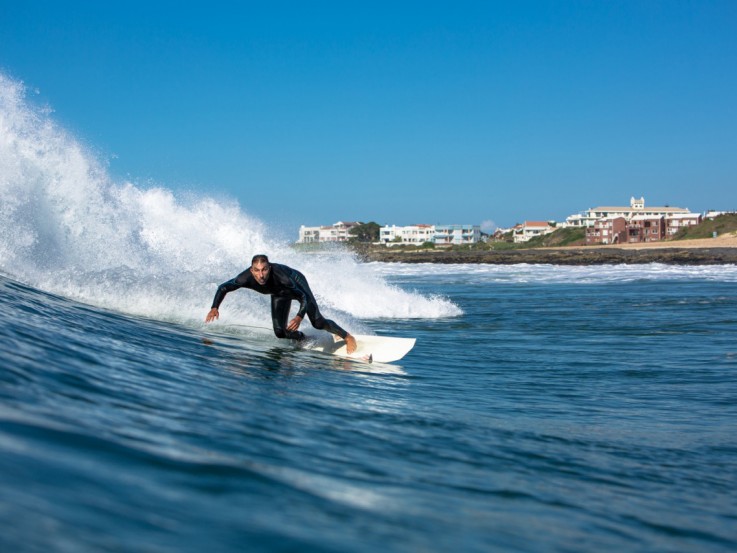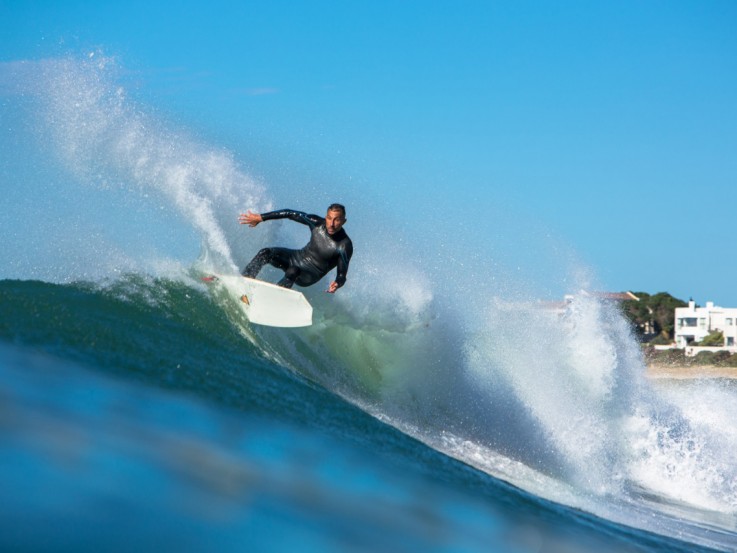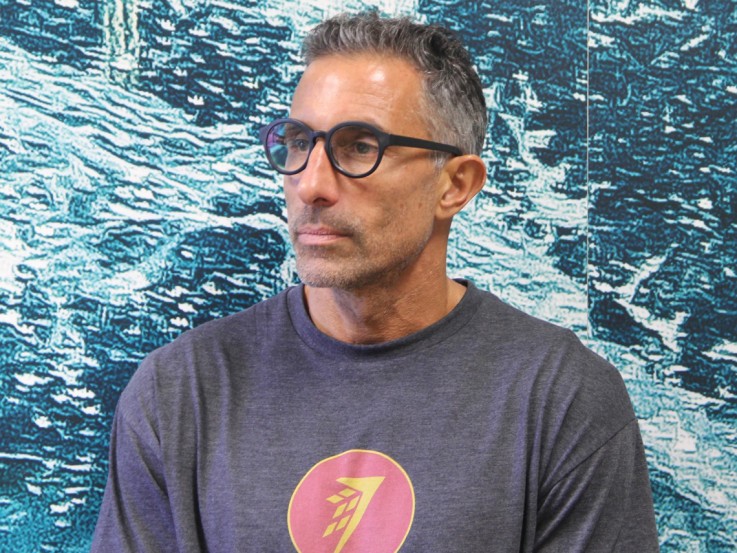Mark Price - Firewire Surfboards
Firewire Surfboards was conceived from humble beginnings in Western Australia. It started out under the name Sunova and was run by Bert Burger. In an effort to expand his business, in 2005 Burger partnered with surfing’s ‘Mad Scientist’ Nev Hyman on the Gold Coast and soon after, action sports industry veterans Dougall Walker and Matthew Perrin jumped on board. In early 2006 former world-ranked pro surfer and consummate ‘surfpreneur’ Mark Price, who was based in San Diego, was also enlisted. From there the company quickly evolved and has become one of the most innovative, in-demand and recognised surfboard brands globally.
Ask Price (now Chief Executive Officer) to articulate what Firewire is and his response will be,
“We’re a surf technology company that happens to make surfboards.”
While his reply may be a little unassuming, the business, the brand and the boards definitely aren’t.
Firewire started with a team of roughly 12 between Australia and the United States and today the company employs more than 150 people. The company distributes to 40 countries and in places as far reaching as Austria, Canada, Dubai, Latvia and Taiwan, and in 2014 Firewire was on track to sell more than 17,000 surfboards, a whopping increase of 3400 per cent on the 500 they sold in their first year.
As the name suggests, Firewire is synonymous with technology and innovation. So it shouldn’t come as a surprise to learn that early on the brand attracted attention from technology God, Apple.
The company was originally named Nev Future Shapes but early on the team recognised that the brand needed to be bigger than one person. While on board a flight to Australia, Price – a self-confessed Apple geek – was on his laptop brainstorming potential names when the term Firewire, the file transfer protocol developed by Apple, came to mind.
“I liked the idea of Firewire – it was techy, it involved wiring, it’s flexible and Apple was a cool company,” says Price.
Firewire got the green light and the team were quick to trademark the name, especially given that Apple hadn’t done so. Three months later Price received a letter from Apple’s attorneys in New York soliciting information about what the company planned to do with the name and ‘politely’ stating they were reserving their right to contest it. As luck would have it Price’s brother-in-law, a former Apple employee, had a very senior contact at Apple, which allowed the fledgling company to circumvent the lawyers. Price explained to Apple that they wouldn’t compete with what Apple were doing, which fortunately for Price and his team they agreed with. In a bizarre twist Apple later sought to use the Firewire trademark for use on promotional merchandise at software tradeshows, which naturally the company agreed to.
“It was a serendipitous situation where not only did we get their blessing but we had to then give them permission to use Firewire, so it worked out well,” says Price.
Serendipity aside, the success of the Firewire brand has been a result of their focus on delivering specialised, high-quality performance boards and a relentless pursuit of continuous improvement. The team engage in weekly research and development (R&D) conference calls and Price says everything Firewire does is based on trying to improve what’s already out there.
“We don’t believe in putting our name on new products just because we have a brand that people desire. We’re constantly focused on R&D and if we can cannibalise ourselves we’re not afraid to do so.”
When the company began production, in 2006, the vast majority of traditional surfboards were made using polyester and resin with wood centre springers. Firewire boards were designed using expanded polystyrene (EPS) foam and epoxy resin and were built using sandwich construction, which involves taking an ultra light foam core and literally sandwiching it under a vacuum between a high-density seal. The centre wood stringer was eliminated and balsa wood rails were run around the permitter of the surfboard, so aside from the shape of the board being similar, in almost every other way - method of construction and materials - Firewire was completely different to everything on the market at the time.
The Firewire method of construction provides the advantage of creating a very lightweight surfboard that still maintains structural integrity, which means the boards are not only lighter but also stronger than a traditional surfboard.
Ideas at Firewire come from a number of fronts. Price says one of the benefits of sandwich construction is working with multiple raw materials, which enable the team to constantly look at different materials and construction methods that can improve performance or durability and flex.
“We all surf, use the product in a really intimate way and are thinking about it all the time. Ideas come from everywhere and there’s a wide variety of people that have contributed to the product development process.”
Firewire also taps into external input and with a reputation for being innovative and open minded, the company attracts a lot of creative people and is often inundated with ideas.
Right off the bat Firewire has provided a product that was greener than their global competitors and the company has built on that by making constant, incremental steps towards sustainability becoming a core business value. In 2005 the Firewire construction method was recognised by EuroSima taking out their Environmental Product of the Year Award.
Price believes that surfers have a big role to play when it comes to sustainability.
“We play in the ocean every day but for some reason we don’t make as much noise about the environment as we should. I believe the average surfer needs to do a lot more to become a greater catalyst for change.”
Sustainability is not just lip service at Firewire, the company is committed to being a good corporate citizen and at the start of 2014 Firewire partnered with Share the Stoke Foundation and alongside FCS Fins and Sticky Bumps donated 150 new Firewire boards to children in third-world countries, including Peru.
So with all that in tow, what can we expect from Firewire in the future?
Firewire is intent on becoming the pre-eminent surfboard company in the world but as Price puts it that doesn’t necessarily mean being the biggest manufacturer. He believes there are too many companies creating too much product and that brands dilute their equity by putting their name on every product under the sun.
“I think brands should go back to being more specialised and focused on particular market segments. Sometimes the business you don’t do is more important than that which you actually do.”
Find Firewire online
| Web: | www.firewiresurfboards.com |
| Instagram: | instagram.com/firewiresurfboards |
| Twitter: | twitter.com/firewireboards |
Shapers Salary Survey
The latest Shapers Salary Survey brought to you by AKU Shaper and Shaperbuddy is completed, download the results by entering your details in the form below.
Posted by: Jaclyn Knight, on January 11, 2015
Categories: Interviews, Articles
Latest Posts
Craig Sims - White Horses & Surfing Life Publisher
Luke Kennedy - Editor of Tracks Magazine
Simon ‘Swilly’ Williams - Surf Photographer
Jarra Campbell - the Bondi Alchemist
Greg Gordon - Owner of CR Surf
Shayne Nienaber - Surf Photographer
Alexa Hohenberg - Owner of Still Stoked
Christine Deveney - TapaReef Owner & Creator
Russell Ord - Surf Photographer
Richard Kotch - Surf Photographer
Categories
Interviews
Articles
Videos
Press Releases
Quiz
Archive
December 2018
November 2018
October 2018
September 2018
August 2018
July 2018
June 2018
May 2018
April 2018
March 2018
February 2018
January 2018
November 2017
January 2017
December 2016
November 2016
October 2016
September 2016
August 2016
July 2016
June 2016
May 2016
April 2016
March 2016
February 2016
January 2016
December 2015
November 2015
October 2015
September 2015
August 2015
July 2015
June 2015
May 2015
April 2015
March 2015
February 2015
January 2015
December 2014
November 2014
October 2014
September 2014
August 2014
July 2014
June 2014
May 2014
April 2014
March 2014
February 2014
January 2014
December 2013
November 2013
October 2013
September 2013
August 2013
July 2013
June 2013
May 2013
April 2013
March 2013











